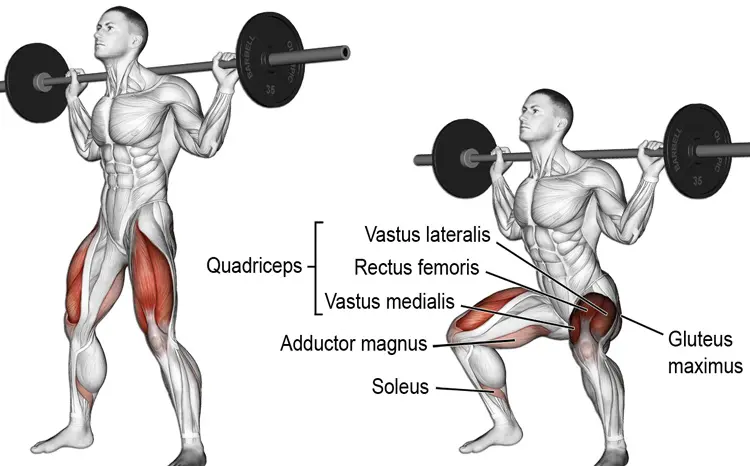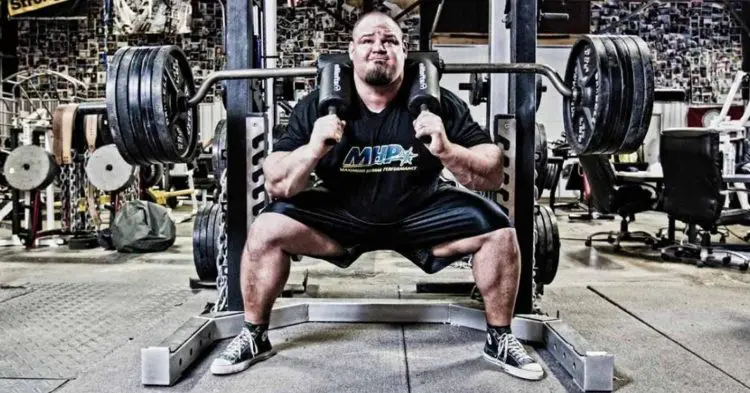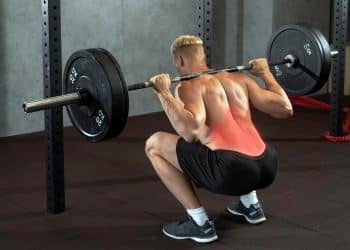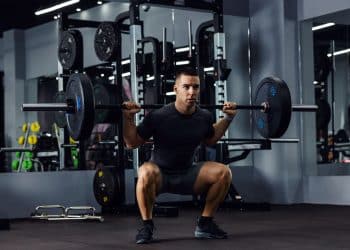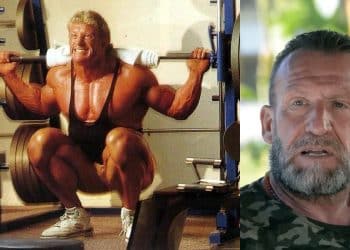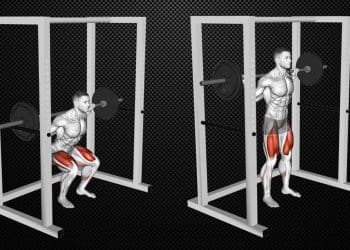The squat is a fundamental strength training exercise. Whatever you are training for, they deserve a place in your workouts. Squats are such a valuable movement that they’re often called the king of exercises.
Squats are also hugely functional. In fact, it’s hard to get through a day without doing at least a few squats. Sitting down and standing up are just two examples of squats in daily life. Doing squats (the exercise) make doing squats (the functional movement) easier and less tiring.
But there are several different squat variations to choose from, and each one offers advantages as well as drawbacks. So that means one type of squat may be better than another for your particular training goal.
Popular squat variations include:
The back squat is arguably the most widely performed of all these squat-based exercises. But did you know that there is more than one way to do back squats? The main two back squat variations are high bar and low bar, referring to the position of the bar on your back.
Both are GREAT exercises, but as each one affects your body slightly differently, it’s important to choose the one that’ll produce the results you want.
Level Up Your Fitness: Join our 💪 strong community in Fitness Volt Newsletter. Get daily inspiration, expert-backed workouts, nutrition tips, the latest in strength sports, and the support you need to reach your goals. Subscribe for free!
In this article, we take an in-depth look at low bar squats, so you can decide if it’s the best back squat variation for your goals.
Low Bar Squats – Muscles Worked
The low bar squat is a compound exercise. That means it involves several muscles and joints working together. It’s safe to say that low bar squats use almost every muscle in your lower body and several upper body muscles too. It’s virtually a full-body exercise!
That said, the main muscles developed by low bar squats are:
Gluteus maximus – known as the glutes for short, the gluteus maximus is the large muscle located on the back of your hip. It’s basically your butt. The glutes are a hip extender and are very active during low bar squats.
Hamstrings – working with your glutes, the hamstrings also extend your hips. Additionally, the hamstrings flex your knees. Located on the back of your thighs, there are three hamstring muscles: the biceps femoris, semimembranosus, and semitendinosus.
Quadriceps – called the quads for short, these powerful muscles are located on the front of your thighs. Their primary function is extension of the knee joint. The quads consist of four muscles: the rectus femoris, vastus lateralis, vastus intermedius, and vastus medialis.
Abductors – low bar squats are typically done with a wide stance. This means they strongly involve the abductor muscles located on the outside of the hips and thighs. The abductors draw the hips out and away from the midline of the body. The main abductor muscles are gluteus minimus, gluteus medius, and tensor fascia latae.
Adductors – using a wide stance means your hip adductor muscles also get a good workout. The three adductors are longus, brevis, and magnus. Located on the inside of your thighs, these muscles draw your hips in toward the midline of your body. During low bar squats, the adductors mainly act as stabilizers by preventing your knees from caving in.
Erector spinae – the erector spinae are your lower back muscles. During low bar squats, they work to minimize lumbar spine flexion. A rounded lower back is a weak lower back, so these muscles play a crucial role during low bar squats.
Core– the core is the collective name for the muscles that make up your midsection. Acting much like a good weightlifting belt, the core squeezes inward to create intra-abdominal pressure, supporting your spine from the inside. The core muscles include the rectus abdominis, transverse abdominis, obliques, pelvic floor, and diaphragm.
How to Do Low Bar Squats
Get more from low bar squats while keeping your risk of injury to a minimum by following these guidelines:
- Place your barbell in a squat rack. It should be 4-6 inches below shoulder height.
- Grip the bar with a wider than shoulder-width grip. Wrap your thumbs around the bar, or use a thumbless “suicide” grip as required.
- Duck under the bar and position it across your shoulder blades – just below your upper traps. Set your shoulders by pulling them down and back. Brace your abs.
- Unrack the bar and step back into your squatting stance. Your feet should be wider than shoulder-width apart, toes turned outward to 15-30 degrees.
- Drive your hips back and bend your knees, descending until your thighs are roughly parallel to the floor. Push your knees out and keep your chest up. Do not round your lower back. Your shins should be relatively vertical at the bottom of each rep, and the weight should be over the middle of your feet.
- Keeping your knees out and your chest up, extend your hips and knees, and stand back up. Stop just short of locking your hips and knees to keep tension on the target muscles.
- Reset your core and repeat.
- Walk forward and re-rack the bar at the end of your set.
Note on Footwear: Low bar squats are usually best done wearing flat shoes. Olympic weightlifting shoes make it harder to keep your shins upright, which moves the load away from your hips and toward your knees. Flat sneakers like Chuck Taylors are a good low bar squat footwear option, or, if your gym allows it, you can also do low bar squats barefooted.
Low Bar Squat Benefits
Not sure if low bar squats are the best exercise for your needs and goals. Consider these pros and cons and then decide:
Lift more weight
Most powerlifters do low bar squats because it’s the variation that usually allows you to lift the heaviest weights. If you are a powerlifter or just want to lift the heaviest weights possible, low bar squats could be the ideal exercise for your needs. Low bar squats make the most of your squatting mechanics:
- The weight is closer to your hips, which takes stress off your lower back
- Glutes and hamstrings are maximally engaged
- The weight doesn’t have to travel as far compared to high bar squats
Lower back-friendly
With the bar lower on your back, the weight is closer to your hips which shortens the lever and, therefore, reduces the stress on your lower back. As such, you should find it easier to maintain an arched (neutral) spine during low bar squats.
More posterior chain engagement
Squats are usually thought of as a knee/quadriceps dominant exercise. The posterior chain (glutes and hamstrings) are involved, but typically to a lesser degree than the quads. Low bar squats are much more hip dominant than high bar squats, making them a more balanced and complete lower body exercise.
Low Bar Squat Drawbacks
While low bar squats are a mostly beneficial exercise, there are also a few drawbacks to consider:
You need good shoulder mobility
Resting and holding a barbell across your posterior deltoids/lower traps requires good shoulder and thoracic spine mobility. If you’ve got tight pecs, anterior deltoids, or lats, you may find it uncomfortable or even impossible to get the bar into the correct position until you fix any tightness or immobility.
You need flexible hips
Wide stance low bar squats require good hip mobility. Lack of hip mobility could reduce squat depth. Improve hip mobility by doing the Asian squat stretch.
Less of a natural shelf for the weight to rest on
With high bar squats, the barbell naturally sits on your upper traps, just below the C7 vertebrae. The position of the bar during low bar squats is less defined and may not feel as natural to some lifters.
Level Up Your Fitness: Join our 💪 strong community in Fitness Volt Newsletter. Get daily inspiration, expert-backed workouts, nutrition tips, the latest in strength sports, and the support you need to reach your goals. Subscribe for free!
Increased tendency to hyperextend the lumbar spine
Low bar squats are initiated by driving the hips back. This is accompanied by a fair amount of forward upper body lean, which can cause some lifters to hyperextend their spines. While not as dangerous as a rounded lower back, hyperextension of the lumbar spine (properly called hyperlordosis) can still result in lower back injury and pain. A strong core and using a weightlifting belt can help prevent this problem.
Shoulder pain and injuries
Low bar squats put a lot of stress on your shoulders. Powerlifters often have shoulder injuries caused or made worse by low bar squats. Because of this, a lot of lifters adopt a very wide grip for low bar squats, which may be more comfortable, but is also often indicative of shoulder joint issues. It also means your grip on the bar won’t be as secure.
7 Low Bar Squat Variations and Alternatives
Low bar squats are a highly effective lower body exercise, but that doesn’t mean you need to do them all the time. There are several variations and alternatives you can use to keep your workouts productive and interesting:
1. Low bar box squats
Low bar box squats involve descending until you are sat on a bench or other platform – the box. Box squats help ensure that you hit the correct depth for each rep. They also break the eccentric/concentric stretch cycle, so you have to work harder to come up out of each rep.
This is useful for increasing power out of the hole. Finally, low bar box squats teach you to lead more with your hips, which is critical for doing low bar squats correctly.
Read more about box squats here.
2. Low bar squats with chains or bands
Doing low bar squats with bands or chains increases the resistance as you approach lockout. This increases muscle tension and encourages you to drive powerfully up and out of the hole, teaching you to use speed to blast through sticking points.
Bands and chains work in more or less the same way, but bands are cheaper and more portable, so you can get some and keep them in your gym bag. However, many gyms have chains, so use them if you’ve got them.
3. Low bar paused squat
Adding a mid-rep pause is one of the easiest ways to add a little variation to your low bar squat workout. Pausing for 3-5 seconds at the bottom point of each rep increases muscle-building time under tension and forces you to explode up, which helps develop strength and power. Powerlifters use paused low bar squats to teach them how to blast through sticking points.
It’s up to you how long you pause at the bottom of each rep, but, needless to say, the longer you pause, the harder this variation becomes.
How to do it:
- Set up for low bar squats are usual.
- Push your hips back, bend your knees, and squat down as far as your mobility and knee health allows. (Read more about squat depth here)
- Hold this position for the required time, typically 3-5 seconds. Stay tight, and do not relax your core.
- After your pause, drive the bar up as powerfully as you can and then repeat.
4. 3-count eccentric low bar squats
You are stronger eccentrically than you are concentrically. That means you can lower more weight than you can lift. Make the most of this phenomenon by doing 3-count eccentric low bar squats. This will increase your time under tension for greater hypertrophy and make light weights feel heavier.
To do this variation, unrack the bar as usual and then squat down for a slow count of three. You can then either pause at the bottom or stand straight up as preferred.
5. Low bar squats with booty/mini band
Low bar squats are already a good glute exercise but adding a booty/mini band makes them even more so. With the resistance band around your legs, you’re forced to push your knees out even more forcefully, increasing gluteus maximus, medius, and minimus activation. This is useful for aesthetics and improves squat performance and technique, especially if your knees tend to fall inward when you do low bar squats.
Place the band around your legs, just above or just below your knees, and then get squatting. Push your knees out against the resistance offered by the band.
Even if you don’t use this exercise for building muscle size or strength, it’s still a good move for warm-ups. Using a band with light weights fires up your glutes so that, when you start the main part of your workout, your muscles are fully activated, so you should be able to generate more force.
6. Kang squat
The Kang squat combines low bar squats with good mornings to produce a demanding, total leg workout. This exercise is not for the faint-hearted and requires good mobility, coordination, and core strength to do correctly.
As such, start with light weights and only go heavier when you’ve perfected your technique. However, once mastered, you should find this exercise useful for increasing low bar squat performance.
How to do it:
- Unrack the bar and adopt your usual low bar squat position. Brace your core.
- Hinge forward from your hips and perform a good morning. Lean as far forward as you can without rounding your lower back.
- Next, bend your legs and descend into a squat. Again, do not round your lumbar spine.
- Continuing to lean forward, drive up and out of the squat.
- Finally, stand up straight by doing a reverse good morning.
- That’s one rep – keep going!
7. Safety bar squat
The safety bar squat is basically the opposite of the low bar squat, but that’s why it’s made it onto our list of alternatives and variations. Low bar squats are notoriously hard on the shoulders, and you need excellent upper-body mobility and flexibility to do them correctly.
Safety bar squats are much more joint-friendly, making them an ideal alternative to low bar squats for anyone with banged-up shoulders.
You can read more about safety bar squats here.
Low Bar Squat – Wrapping Up
Low bar squats are a valuable exercise for athletes and anyone looking to get strong, but not so helpful for bodybuilders and general exercisers.
If you want to increase posterior chain activity during squats, lift more weight, or build a bigger butt, low bar squats will make an excellent addition to your workouts. They’re a great exercise for powerlifters and the type of squat you are most likely to see in powerlifting meets.
That said, you will need good shoulder mobility to achieve the correct bar position. You’ll also need to ditch your Olympic lifting shoes and get yourself some flat sneakers like Chuck Taylors to do low bar squats correctly.
Can’t decide between low bar squats and high bar squats? Why not squat twice a week and do both variations? That way, you can enjoy all the benefits these two exercises have to offer.
Interested in measuring your progress? Check out our strength standards for Overhead Squat, Zercher Squat, Good Morning, and more.

